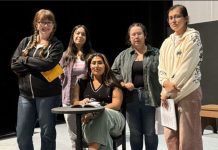El Cajon has got talent — specifically, this East County city has impressive authors among its residents. And the El Cajon Library showed off three of the area’s accomplished book writers on the afternoon of Saturday, Jan. 21. The event was the Local Authors Expo.
El Cajon has got talent — specifically, this East County city has impressive authors among its residents. And the El Cajon Library showed off three of the area’s accomplished book writers on the afternoon of Saturday, Jan. 21. The event was the Local Authors Expo.
An unexpected full house of attendees filled the audience seats on a stormy weekend. First up among the trio of authors to address the listeners was C.E. “Ed” Gauss, who spoke about his spy action novel, “The Alexandria Seal. “Gauss informed the audience that he’d lived in El Cajon since he was 13, in one of the city’s older neighborhoods. He started his talk by noting that his fiction novel was based on real incidents that defied easy explanation.
During the waning days of World War II, in about 1943-1944, an unusual German fighter plane was discovered that possessed surprising technological features. This airplane was a “flying wing” bearing a great resemblance to modern-day stealth aircraft designs. The aircraft had a mysterious black coating that apparently evaded radar detection of the time.
Moreover, the twin-jet-engine plane boasted twice the speed, twice the maneuverability, of the Allies’ fighter aircraft. The mystery plane had capabilities of flying at 650-700 mph, while British and American aircraft topped out at about 400 mph.
“The real is often more interesting that fiction,” Gauss stated. “I put this book together to touch reality.”
And that, he has done, with fascinating imaginative twists and historical embellishments. The tale his book tells is of purported, nearly-lost advanced technological knowledge dating back to the Library of Alexandria in fifth century Egypt. Fast-forward to 20th century actual events, as Northrop Grumman acceded to a request from the Smithsonian Institution to build a mock-up of that old German mystery “stealth” airplane.
The novel Gauss has written, based on blending his imagination with historical reality, is an engaging book, with multiple strands, several running plots and leaps from ancient to recent event timelines. The culmination arrives at current concerns, over preventing terrorist detonation of a nuclear device in today’s Middle East.
Gauss had intriguing advice for other writers. “Timing is everything,” he observed. He noted the advantage of having a broad swath of experience, “I have based my characters on the very interesting people I have met, including for wont of a more diplomatic word, whackadoodles.”
Second author to grace the library podium was Lynn Manyfires, discussing her book, “Ceremonies of the Red Road” Her book recounts personal experiences with the Lakota Dakota Sioux ceremonies that teach “How to Become a True Human Being.” Those ceremonies “honor the deepest truths in life,” Manyfires said.
The Inipi, or Sweat Lodge ceremony, dates back thousands of years and is practiced by many Native American tribes. Its purposes are for participants to pray and purify themselves. The Cannunpa, or Pipe Ceremony is performed singly or in groups, for prayers, cleansing and purification, protection and for acknowledging truth in treaties and agreements.
Manyfires described other important ceremonies, including the Vision Quest seeking a spirit helper for lifelong guidance on how to live well, and the Sundance of “an intensive four days of praying, chanting, singing, dancing and offerings to the Creator.”
Manyfires concluded with “A Feather Teaching,” noting how an eagle feather is sacred to the Lakota as “a perfect centerpiece” to teach about living rightly. The center spine is the Creator’s design for each individual life. Taking the wrong path, though, is akin to splitting feathers apart on either side as lives go astray from wrongful actions such as dishonoring parents or elders, disrespecting Mother Earth, abusing drugs or alcohol. But as she stroked the eagle feather back upward, she said that a “return to the Creator” can restore that “perfect” life’s path. “This is the hope represented by the feather,” she concluded.
Last but not least was Amanda Matti, whose young family moved to El Cajon in 2013. Her real-life account of finding true love in the midst of the Iraq War is the central storyline in her book, “A Foreign Affair”. Her well-written book will capture readers’ engagement with the story from first page to last.
Matti enlisted in the Navy to see the world and exchange her military service for education benefits. And then 9/11 occurred.
Matti’s training as a Russian linguist, translator and analyst allowed her the opportunity to deploy overseas to advance her military career. In 2005, she volunteered and was sent to Baghdad as part of the efforts in Operation Iraqi Freedom. Soon after her arrival as a Foreign Affairs Liaison Officer, she met a young Iraqi man, Fadi Matti, who was assigned to work side-by-side as her translator in intelligence analysis. The pair worked together, deployed together — and soon fell in love with each other.
Despite that Fadi bled, suffered and been threatened alongside U.S. troops in combat operations, as a result of their love affair she was suspected of multiple misdeeds. They were separated, being sent stateside before her deployment ended. Both were interrogated harshly, kept under strict scrutiny, and only reunited after she was punished for disobeying an order against communicating with Fadi. (Being an Iraqi translator for coalition forces was at the time the most dangerous job in the world. Amanda contacted him because she feared for his safety.)
The young couple’s story has a very happy ending, however, although she endured an “extreme double standard” between men and women in U.S. military service. She obtained a fiancé visa for Fadi, and they wed when he arrived. They have two young daughters, and family members who immigrated from Iraq to El Cajon.














